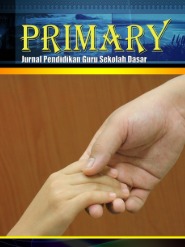4C abilities (critical thinking, communication, collaboration, creativity) of elementary school students in learning the Indonesian language
DOI:
https://doi.org/10.33578/jpfkip-v13i5.p191-200Keywords:
4c abilities, critical thinking, communication, collaboration, creativity, Indonesian language, elementary schoolAbstract
This research is motivated by students' inability to solve problems and express ideas, and students find it challenging to develop their abilities, especially in learning Indonesian. So, students need to be able to solve problems with their abilities. In this case, the education system must realize that students can think critically, communicate well, collaborate, and be creative. This research aims to describe the 4C abilities (critical thinking, communication, Collaboration, Creativity) of SDN 193 Pekanbaru students in learning Indonesian. This descriptive qualitative research uses data collection techniques, observation, interviews, and documentation. Data analysis techniques use data reduction, data presentation, and conclusions. The results show that students at SDN 193 Pekanbaru have 4C abilities, which include critical thinking skills, communication, Collaboration, and Creativity. However, even though students already have the 4C skills, there are still students who have not been able to master these four abilities due to a lack of interest in developing their skills, and at SDN 193 Pekanbaru, there are inclusion students. In this case, teachers always guide and hone students' abilities through various learning activities.
References
Abdussamad, Z. (2021). Metode Penelitian Kualitatif. CV. Syakir Media Press. https://books.google.co.id/books?id=JtKREAAAQBAJ
Angga, Suryana, C., Nurwahidah, I., Hernawan, A. H., & Prihantini. (2021). Comparison of Implementing the 2013 Curriculum and the Independent Curriculum of the Basic School. Basicedu Journal, 6(4), 7174–7187. https://doi.org/10.31004/basicedu.v5i4.1230
Anggito, A., & Setiawan, J. (2018). Metodologi penelitian kualitatif. CV Jejak (Jejak Publisher). https://books.google.co.id/books?id=59V8DwAAQBAJ
Aprilya, A. P., & Press, A. (2020). Penggunaan Model Inquiry Learning Dalam Pembelajaran. Ahlimedia Book. https://books.google.co.id/books?id=NVYNEAAAQBAJ
Berjamai, G. S., & Davidi, E. I. N. (2020). A Study of Factors Inhibiting Critical Thinking Skills of Grade V Elementary School Students in Indonesian Language Subjects. Journal of Elementary Education Literacy, 1(1), 44–49.
Damayanti, N. M., Kholili, M. I., & Dewantoro, A. (2023). The Relationship between Self-Confidence and Student Interpersonal Communication. Journal of Psychoeducation and Counseling, 7(1), 9. https://doi.org/10.20961/jpk.v7i1.71319
Faroh, M. N., Maranting, H. S., Munir, D. R., Bua, M. T., Wardani, K. D. K. A., Rahmawati, E., & Triana, T. (2023). Profesi Keguruan. Pradina Pustaka. https://books.google.co.id/books?id=xrTmEAAAQBAJ
Fatmawati. (2022). Creativity and Intelligence. Journal of Education and Counseling, 4(5), 189. https://journal.universitaspahlawan.ac.id/index.php/jpdk/article/view/6562
Firman, Syamsiara Nur, & Moh. Aldi SL. Taim. (2023). Analysis of Student Collaboration Skills in Biology Learning. Diklabio: Jurnal Pendidikan Dan Pembelajaran Biologi, 7(1), 82–89. https://doi.org/10.33369/diklabio.7.1.82-89
Gabriella, F., Asyiffa, A., & Sitorus, F. K. (2023). Analysis of Aristotle's Views on the Five Functions of Language in Communication. JKOMDIS: Journal of Communication and Social Media Sciences, 3(3), 725–729. https://doi.org/10.47233/jkomdis.v3i3.1247
Haribowo, R. (2022). Soft Skills and Leadership Textbook. Nas Media Pustaka. https://books.google.co.id/books?id=Ax5oEAAAQBAJ
Mrizkidirmansyah, & Febriandi, R. (2023). Improving the Mathematics Problem-Solving Ability of Elementary School Students by Implementing the Problem-Based Learning Model. Journal of Elementaria Edukasia, 6(4), 2135–2144. https://doi.org/10.31949/jee.v6i4.7591
Nani, N., & Hendriana, E. C. (2019). Analysis of Student Learning Difficulties in Indonesian Language Learning in Class V SDN 12 Singkawang. Journal of Educational Review and Research, 2(1), 55. https://doi.org/10.26737/jerr.v2i1.1853
Nella Agustin, et al, Mardati, A., Sukma, H. H., Martaningsih, T., & Maryani, I. (2021). The Role of Teachers in Shaping Student Character (Anthology of Student Essays on Elementary School Teacher Education). UAD PRESS. https://books.google.co.id/books?id=Njs1EAAAQBAJ
Nita, O. (2019). The Relationship between Creativity and Indonesian Language Learning Outcomes. Journal of Language, Literature and Teaching Studies (KIBASP), 3(1), 92–103. https://doi.org/10.31539/kibasp.v3i1.903
Nurwahidah, N., Samsuri, T., Mirawati, B., & Indriati, I. (2021). Improve students' collaboration skills using scientific-based student worksheets. Reflection Journal, 1(2), 70–76. https://doi.org/10.36312/rj.v1i2.556
Patresia, B., & Kurniah, N. (2019). Application of Asking Teacher's Skills to Improve Children is Speaking and Listening Skills at Pembina Lebong State Kindergarten. 28(7), 1297–1306.
Riyanti, B. P. D., Sihotang, K., & Amarasthi, N. P. (2019). Creativity and Innovation in the Workplace. Unika Atma Jaya Jakarta Publisher. https://books.google.co.id/books?id=ByagDwAAQBAJ
Sakdiyah, H., AKA, Z. A., & Febriyanni, R. (2023). Efforts to Improve Learning Outcomes: Applying the Jigsaw Cooperative Learning Model in Fiqh Subjects for Grade VIII Students of MTsS Plenary Besitang. Edu Society: Journal of Education, Social Sciences and Community Service, 2(2), 591–603. https://doi.org/10.56832/edu.v2i2.196
Sari, D. V. P. M., Aini, K., Syarifah, Damayanti, F., Handayani, T., & Nurokhman, A. (2021). Review: Critical Thinking in Students. Proceedings of the National Seminar on Biology Education, 5(1), 104–111. http://proceedings.radenfatah.ac.id/index.php/semnaspbio
Susanti. (2021). Teachers' Efforts in Applying Mutual Respect for Fellow Early Childhood Kindergartens at Kindergarten Tunas Muda Ulee Tuy Darul Imarah Aceh Besar. Scientific Journal of Child Education, 6(1), 59–76. https://jurnal.serambimekkah.ac.id/index.php/aulad/article/view/90
Virza, R., & Lestari, A. (2023). Applying the 4C (Communication, Collaboration, Critical Thinking, Creativity) in the Independent Curriculum at the high school level. 0435, 15–26.
Widodo & Wardani. (2020). Mengajarkan Keterampilan Abad 21 4C (Communication, Collaboration, Critical Thinking and Problem Solving, Creativity and Innovation. 7(september), 185-197.
Yulia, W. (n.d.). Andai Aku Jadi Penyiar. Penerbit Andi. https://books.google.co.id/books?id=GAET7QN7n0gC
Downloads
Published
Issue
Section
License

This work is licensed under a Creative Commons Attribution-NonCommercial-ShareAlike 4.0 International License.
Licence
Copyright @2017. This is an open-access article distributed under the terms of the Creative Commons Attribution-NonCommercial-ShareAlike 4.0 International License (http://creativecommons.org/licenses/by-nc-sa/4.0/) which permits unrestricted non-commercial used, distribution and reproduction in any medium
 This work is licensed under a Creative Commons Attribution-NonCommercial-ShareAlike 4.0 International License.
This work is licensed under a Creative Commons Attribution-NonCommercial-ShareAlike 4.0 International License.


